UAH Misrepresentation Anniversary, Part 2 - Of Cherries and Volcanoes

 In Part 1 of this post, we examined the overconfidence that Roy Spencer and John Christy displayed in the University of Alabama at Huntsville (UAH) atmospheric temperature data - particularly in ther lower tropospheric temperature (TLT) estimates - in a press release marking the 33rd anniversary of the UAH satellite temperature record. In Part 2 we will examine a number of other misleading and false claims made in the press release.
In Part 1 of this post, we examined the overconfidence that Roy Spencer and John Christy displayed in the University of Alabama at Huntsville (UAH) atmospheric temperature data - particularly in ther lower tropospheric temperature (TLT) estimates - in a press release marking the 33rd anniversary of the UAH satellite temperature record. In Part 2 we will examine a number of other misleading and false claims made in the press release.
Out of Step with Reality
The UAH press release repeats the myth that the observed warming is just a step function change (a flat period followed by a spike, followed by another flat period) due to the El Niño in 1997-1998:
"There was little or no warming for the first 19 years of satellite data. Clear net warming did not occur until the El Niño Pacific Ocean “warming event of the century” in late 1997. Since that upward jump, there has been little or no additional warming."
The UAH data directly contradicts the claims in this quote. We can see this by examining the trends while excluding the 1997-1998 El Niño. The UAH trend from 1979 to November 1997 is 0.04°C per decade - small, but a net warming. The trend from January 1999 through November 2011 is 0.18°C per decade - very clear warming, contrary to the press release claim. In fact, the post-El Niño trend exceeds the trend for the entire record of 0.14°C per decade (Figure 1).
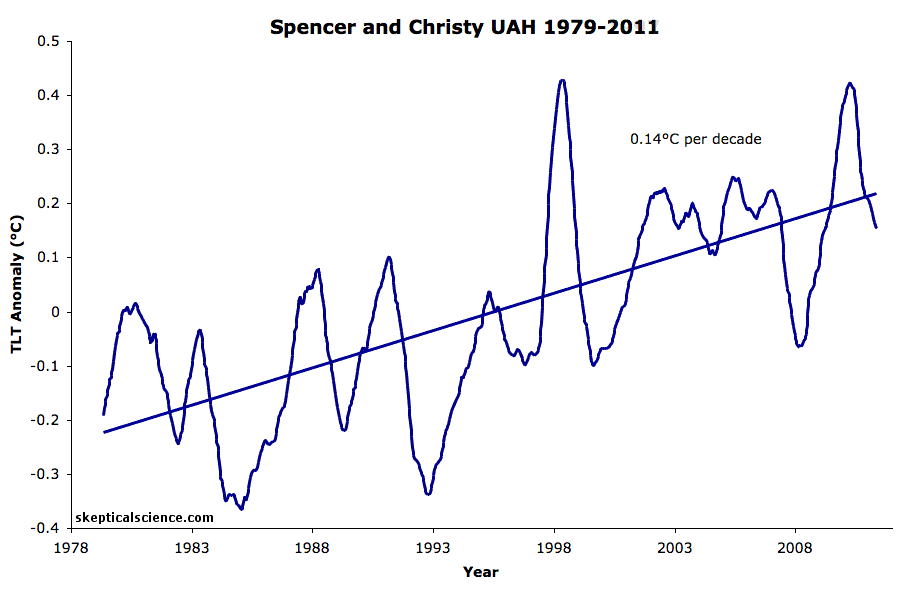
Figure 1: UAH data and linear trends for 1979 to November 1997, January 1999 to November 2011, and the full 1979 to 2011 record (12-month running average applied for smoothing).
Of course, Spencer and Christy may well have meant not 'since that upward jump' but 'including that upward jump'. Indeed, from January 1998 to November 2011 the UAH trend has a low value of 0.06°C/decade. It is, however, very easy to find low trends if you cherry pick your start and end points. Spencer and Christy owe us, but do not provide some physical reason why we should expect a 'step change' as a result of the 1997-1998 El Niño, and not (for example) from the 1999-2000 La Niña. The obvious explanation as to why no physical reason is given is that suggesting such step changes from El Niño events is absurd. Appealing to them, however, sounds like an explanation, even though no explanation is actually given. It acts, in other words, as a nice form of words to defuse any tendency to critical thought.
If there was a step change in temperature after the 1997-1998 El Niño, it would show up clearly as elevated temperatures after that event when we first filter out short-term influences on TLT, as Foster and Rahmstorf (2011) did (more on this paper below). As Figure 2 shows, such an elevated jump in temperatures is absent from the record when the short-term influences (including El Niño) are filtered out. What's more, the 1979 to 1999 trend is 0.10°C per decade, while the 1999 to 2010 is 0.21°C per decade, which again easily exceeds the trend for the entire record of 0.14°C per decade. This clearly shows that Spencer and Christy's "upward jump" is an artifact of cherry picked starting points for a period short enough to be dominated by short-term fluctuations in temperature.
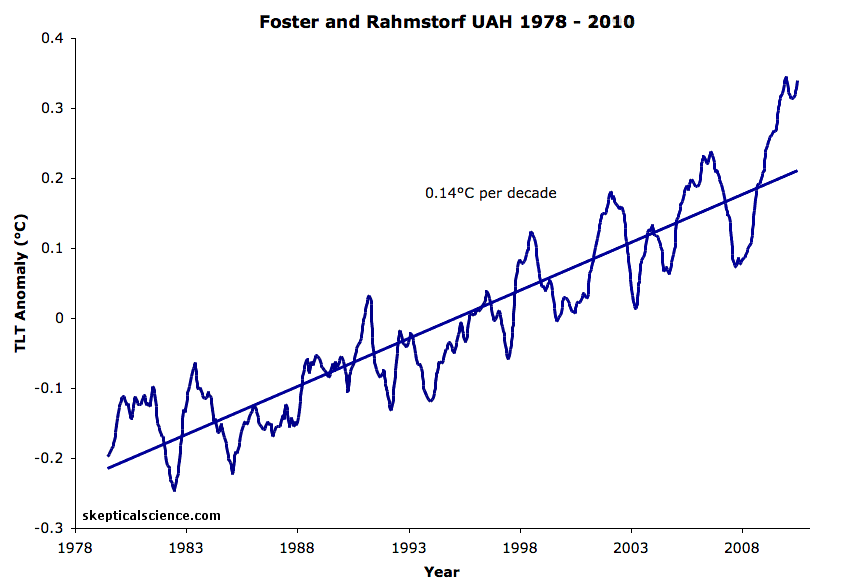
Figure 2: UAH data and linear trends for 1979 to 1997, 1999 to 2010, and the full 1979 to 2010 record after volcanic, solar, and El Niño factors have been removed by Foster and Rahmstorf (2011). 12-month running average applied for smoothing.
In short, the UAH press release claim that the TLT record is just a step change with no warming before or after the 1998 El Niño event is completely wrong.
Christy Cherrypicking
Later in the article, Christy discusses what happens to the UAH data when the effects of volcanic eruptions are removed:
"Part of the upward trend is due to low temperatures early in the satellite record caused by a pair of major volcanic eruptions. Because those eruptions pull temperatures down in the first part of the record, they tilt the trend upward later in the record...When that cooling is subtracted, the long-term warming effect is reduced to 0.09 C (0.16° F) per decade, well below computer model estimates of how much global warming should have occurred."
First, why is Christy removing the volcanic forcing from the UAH data without removing it from the models? This is not an apples-to-apples comparison.
Second, while removing the short-term natural influence of volcanic eruptions is a valid analysis (if done correctly), it also makes us wonder, why only volcanoes? After all, there are other short-term natural influences on the global surface and atmosphere temperatures, like solar activity and the El Niño Southern Oscillation (ENSO) for example.
We recently examined a paper by Foster and Rahmstorf (2011) which removed all three of these influences from the temperature record using multiple regression. They found that, as Christy notes, the timing of volcanic activity has resulted in a slight warming trend over the past 33 years. However, decreased solar activity (measured by either total solar irradiance [TSI] or sunspot number) and ENSO cycles have both had cooling effects since 1979. Their net effect on UAH has been approximately zero, and they have had a net cooling effect on the other major temperature records (Table 1).
Table 1: Trends in °C/decade of the signal components due to ENSO (as measured by the Multivariate ENSO Index [MEI]), volcanoes (as measured by aerosol optical depth [AOD]), and TSI in the regression of global temperature, for the major temperature records from 1979 to 2010. Source: Foster and Rahmstorf (2011)
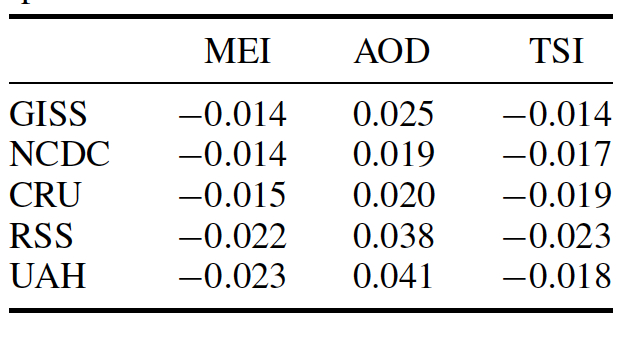
Quantifying Man-Made Warming
Next up in the article, Roy Spencer denies that we can quantify the amount of warming caused by human greenhouse gas emissions:
"How much of that underlying trend is due to greenhouse gases? While many scientists believe it is almost entirely due to humans, that view cannot be proved scientifically"
As a matter of fact, two recent studies have taken distinct and clever approaches to quantify how much of the warming trend is due to humans. The aforementioned Foster and Rahmstorf paper filtered out the effects of the three largest short-term natural influences on global temperature, and estimated the resulting (almost entirely man-made) trend at approximately 0.16°C per decade since 1979 (Figure 3).
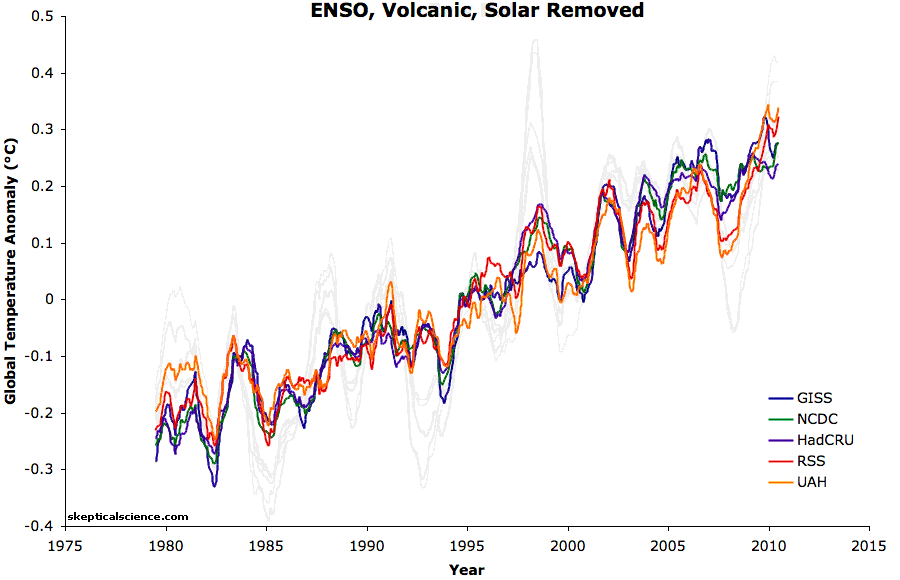
Figure 3: Temperature data (with a 12-month running average) before and after the Foster and Rahmstof removal of solar, volcanic, and ENSO influences.
Huber and Knutti (2011) found essentially the same result by applying the principle of conservation of energy. They determined that approximately 100% of the warming since 1950 has been caused by human effects (Figure 4). In fact, because substantial warming has been offset by human aerosol emissions, Huber and Knutti concluded that greenhouse gases have caused 66% more warming than has been observed since 1950.
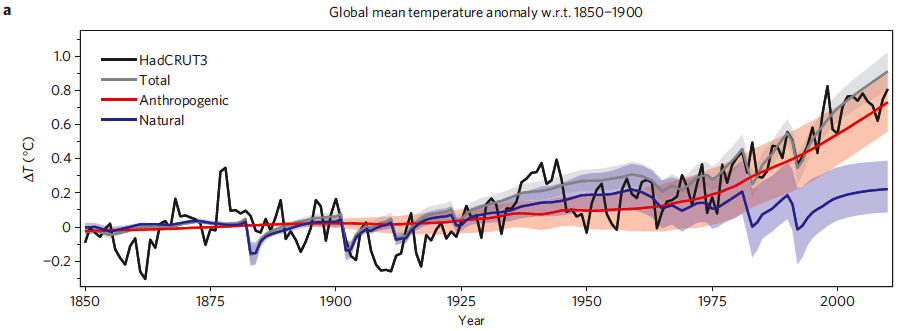
Figure 4: Time series of anthropogenic and natural forcings contributions to total simulated and observed global temperature change. The colored shadings denote the 5-95% uncertainty range. Source: Huber and Knutti (2011)
Moreover, scientists have observed a number of 'fingerprints' of human-caused warming (Figure 5).
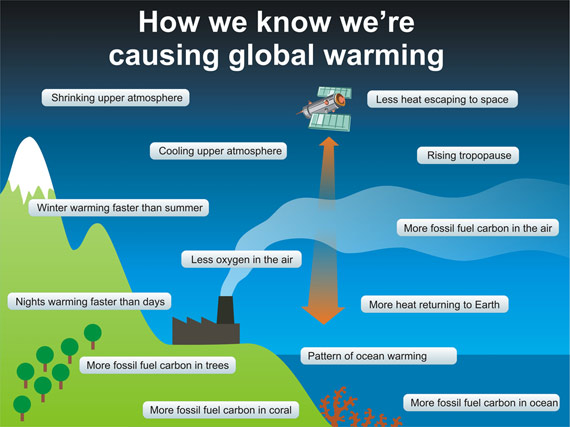
Figure 5: 'Fingerprints' of human-caused warming
Spencer expanded on his claim in his follow-up blog post:
"In my opinion, the supposed “fingerprint” evidence of human-caused warming continues to be one of the great pseudo-scientific frauds of the global warming debate....Many papers indeed have claimed to find a human “fingerprint”, but upon close examination the evidence is simply consistent with human caused warming — while conveniently neglecting to point out that the evidence would also be consistent with naturally caused warming."
While it's true that many of these examples are simply consistent with what we expect to see from anthropogenic warming, it's not a coincidence that they are indeed all consistent with human-caused warming. Nobody (including Spencer) has yet put forth an alternative hypothesis for the observed global warming which could explain all of these 'fingerprints'. Moreover, as noted above, we know the warming is human-caused based on both statistical (i.e. Foster and Rahmstorf) and physical (i.e. Huber and Knutti) approaches. At some point, one has to accept the multiple lines of overwhelming evidence all pointing in the same direction.
UAH Misrepresentation and Self-Contradiction
In this UAH press release, Spencer and Christy have made a number of unsupported and misleading statements, based on the UAH temperature data. While it's true that there is a discrepancy between the model-expected and observed ratios between lower atmosphere and surface warming, the ratio is not nearly as large as Christy claims, as shown by Santer et al. (2011). Moreover, Christy's assumption that the problem lies with the models, rather than his own data, is unsupported, and in fact a cool UAH bias may very well be the most likely explanation for the discrepancy. In fact, that was the conclusion of a U.S. Climate Change Science Program (CCSP) document in 2006, on which John Christy himself was a lead author (emphasis added):
"These results could arise either because “real world” amplification effects on short and long time scales are controlled by different physical mechanisms, and models fail to capture such behavior; or because non-climatic influences remaining in some or all of the observed tropospheric data sets lead to biased long-term trends; or a combination of these factors.
The new evidence in this Report favors the second explanation."
Christy also made a misleading claim about the warming thus far not obviously representing impending disaster, leaving out critical information like the rate of warming and future expected warming. Spencer made perhaps the most misleading assertion, claiming that the human contribution to the observed warming can't be quantified, when in fact a number of scientific studies have done exactly that using a number of different methodologies, including two published in the past couple of months. The aforementioned CCSP document on which Christy was a lead author also contradicts Spencer here:
"Fingerprint studies have identified greenhouse gas and sulfate aerosol signals in observed surface temperature records"
All in all, not an auspicious way to celebrate the UAH data set 33rd anniversary. It's worth noting that Spencer and Christy admit that there has been warming, and they have previously acknowledged that some amount of that warming is due to human activities. However, their comments in this press release reveal a number of attempts to downplay the amount of warming, the danger it represents, the human contribution, and the fact that their data set is the outlier.
Posted by dana1981 on Wednesday, 28 December, 2011

 In Part 1 of this post, we examined the overconfidence that Roy Spencer and John Christy displayed in the University of Alabama at Huntsville (UAH) atmospheric temperature data - particularly in ther lower tropospheric temperature (TLT) estimates - in a press release marking the 33rd anniversary of the UAH satellite temperature record. In Part 2 we will examine a number of other misleading and false claims made in the press release.
In Part 1 of this post, we examined the overconfidence that Roy Spencer and John Christy displayed in the University of Alabama at Huntsville (UAH) atmospheric temperature data - particularly in ther lower tropospheric temperature (TLT) estimates - in a press release marking the 33rd anniversary of the UAH satellite temperature record. In Part 2 we will examine a number of other misleading and false claims made in the press release.






